106 S1 & S2 RALLYE
BUYING GUIDE
Take your time and dont rush your inspection, and
try not to view the car at night or in rain. Just
follow the following rough basic guide and check
bodywork, mechanical and interior parts of the car.
1) VISUAL INSPECTION (Bodywork)
Look along each side of the car for ripples or
uneven surfaces, and poor repairs suggesting
the car has been in an accident. This is usually
most visible by paintwork mismatch. Just because
a car has had paint doesn't mean it should be
discarded - as long as the paint or/and repair
has been treated/repaired correctly proceed with
the inspection. Another sure sign of paint is
overspray. Examine all the window seals for signs
of overspray and paint build up, aswell as around
badges. If the car has had a total respray ask for
details on where the car has been sprayed and reasons
as to why - its not neccessarily a bad sign, especially
if carried out on older cars, but some unscrupulous
people will do this to hide the body work of the car
for a quick couple of hundred. Check the roof
for filler or repair which could suggest a serious
accident. Filler repairs are noticeable by 'shrinkage'
marks, most noticeable in winter, 'orange peel' is
another sign of poor paint repairs - the surface
being rough in appearance. Rallye Standard colours
are Indiglo Blue and Bianca White (S2) and Cherry
Red, Black and Bianca White (S1). Rallye decals are
fitted as standard - with a long coloured stripe on
each flank on the S1 with smaller rallye logo's on
the S2 - both have a bonnet rallye decal and rear
rallye badging - fading of these especially on S1's
is very common. S2 has rallye writing near lower rear
arch. White steels are standard fitment to the rallye
and oversized alloys (15 and above) can cause problems.
2) VISUAL INSPECTION & CHECKS (underbonnet)
Lift the bonnet and check for any misalignment. Check
the chassis number on the scuttle pannel (on V5) aswell as
the engine code (stamped on the block on the S2, stamped
on an aluminium plaque and rivitted on the S1). Pull
put the dipstick and check the oil level and quality.
Sludgy oil or excessive low level could mean neglect or
poor maintenance. Open the radiator cap, make sure the
water is clean and free from oil. Dont be alarmed by
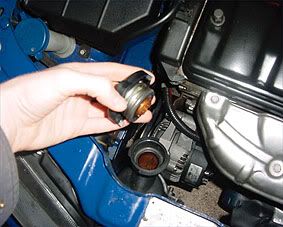
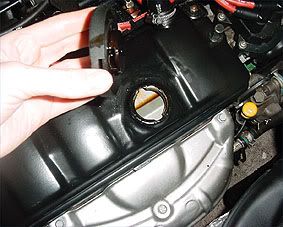
small amounts of rust deposits, but alot of rust could
again signify poor maintenance. Antifreeze is a sign
of good ownership and also acts as a corrosion inhibitor.
Open the oil filler cap and check for excessive build
up of white 'mayonaise' deposits or 'mulsh'. A mixture
of oil and water suggests head gasket failure - although
a small build up due to condensation and weather mean
that mulch can appear on the rocker cap without the gasket
going. Open the boot - lift up the mat and check for repairs
or signs of paint/filler suggesting a rear bump. Get underneath
the car - or take someone who knows what to look for. Check
the front end for signs of bush wear on lower wishbones and
engine mount/s. Check for signs of oil leakage and water leaks.
Common oil leaks occur around the rocker gasket, common coolent
leaks occur around the 3 bleed nipples, the oil cooler piping,
and the thermostat housing. Check the sills, rust shouldn't be
a problem, but look for signs of 'crimping' where by the
car may have had equipment attatched to be 'jigged'. Back
under the bonnet check for new parts, this can be a sign of
good ownership. (new battery, new alternator etc). An old
saying goes like this 'All that glistens isn't gold' so
a clean engine bay doens't mean the car is better mechanically
than a dity engine bayed car.
Many rallyes have had new engines fitted - making it hard to
know what to look for - Check the new engine has been registered
on the V5 and that the engine code/cc matches. Ask for receipts,
details, as much info as possible about this engine - is it
guaranteed? cost? who fitted it - is the mileage genuine?? This
can be a dark area as this is an area where by alot of the info
can be hazy, but you just have to check as best you can.
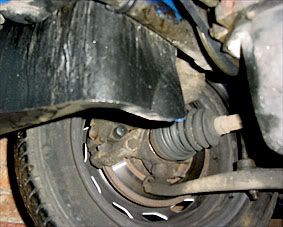
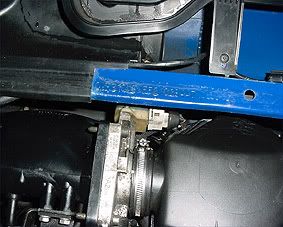
Other areas include under bonnet modifications, of which there
are far too many to go into detail. I would as a guide just
check for fitment of these (is it good, secure) and can it be
changed back to standard easily - and has the owner got the OE parts
still. An airbox can cost up to £80 to buy new!! And be careful,
any modification from what the manufacturer intended can have
an effect on the running of the car.
3) PAPERWORK/HISTORY
Ask to see all history, receipts etc. Check as much as you
can - dont be rushed. A dealer stamped book is nice, but generally
has little impact on how well maintained the car is. As long as
the car has been serviced by someone competent - either the owner
or a garage - it doesnt matter. Most older cars will have been
serviced at smaller garages or by the owner. Expect to find on
most servicing carried out by the dealer until the warranty ran
out. OE parts receipts are good, aswell as receipts for aftermarket
parts, even 2nd hand parts - all info is good, telling you what
has been carried out and when. Little or know history usually means
lots of short term ownership. Dont be alarmed by major work - most
S1 rallyes will have had atleast 1 head gasket/cam belt by now.
Receipts/notes/dates for these are useful. Dont assume because alot
of parts or money has been spent this is a bad car - it often means
the owner has spent a fortune getting it right - and you will often
reap the benefits. Personally I would want a HPI report - these cars
are often stolen, crashed and thrashed so cover your self. I have mine
infront of me now. It gives details of previous HPI inspections, all
the engine code details, chassis details, colour, registration etc and
most importantly most (not all!!) accidents where by the car has a Cat
rating and finance outstanding. Expect to pay around 20-30 quid if
your not in the trade. Ask to see current/old MOT's.
4) TEST DRIVE
Start the engine - FROM COLD - Listen for rumbling and knocking
noises in the first few seconds. Check for blue smoke from
the exhaust which can mean a worn engine. Check every gear
for engagement and check the clutch, try and make it slip.
Leave the handbrake on and engage the clutch...slowly. Check
all electrics, fans, radio etc. Check the warning lights - do
they all work, make sure there is no engine management light
on, now low battery warning light etc. The oil guage takes
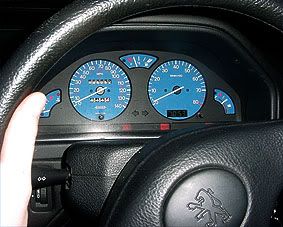
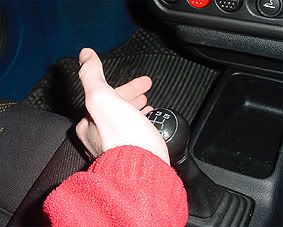
forever to move, but the coolent guage should start moving after
around 5-10 mins - keep on eye on this throughout the drive.
It should go as high as 3/4 and no more really. Check there is
no oil pressure warning light. This light should be on before
you start the car and then go out - if it doesnt light first
chances are it may have been disconnected!! Start to drive away,
loud injector noise and tappet noise are very common, so expect
the engine to sound 'tickety' 'tappety' when cold. It shouldn't
be excessive though. The idle especially on the S1 is very lumpy,
and should idle around the 1k mark, higher when cold. Choke
is electronic controled by ECU, so it shouldn't cut out when cold.
On the drive check the speedo moves...not always smoothly on
peugeots and the odometer works. Sloppy gear travel suggests worn
linkages, lot of crunching on gear changes means worn syncro's.
However all older peugeots have very stiff gears when cold.
Check the car pulls smoothly through all the gears - take your
hands off the wheel and check for judder at high and low speeds.
Take a few slow corners on full lock, listen for CV joint graunching
noises and bearing noise. Feel the ride, it should be firm on a
standard rallye. Des the car drive straight and not wander, does
it brake in a straight line - are the brakes good! Just check as
much as you can and listen for suspect noises. Expect rattles though
peugeots are fragile so dash rattle and bits falling off the
interior are common. Check the interior condition. Worn seats are
normal in peugeots. Expect steering to be stiff/heavy as there is
no power steering as standard (unless requested). When you get back
jump out and check under bonnet again for water leaks, oil etc..etc.
The S1 needs to be revved higher in order to achieve its max BHP so
dont be scared to give it some beans on the test drive, it has to
cope with being driven at high revs. Torque is lacking so dont expect
it to pull like a steam train through the gears. The S2 has
bags of torque and this should be felt in each gear. Again this
area is so vast I have just covered the basics.
5) THE PURCHASE
If you are happy with the car I suggest leaving a deposit and
getting the HPI report before proceeding. Use this time to haggle
on any faults you have noticed and anything else such as MOT, tax
etc.. Dont rush into anything - a deposit of 20-100 pounds will
usually secure a car for a day or two - so have a think. Re-check
anything you feel neccessary. Rallyes can vary vastly in price. As
I know a few people in the trade I can access CAP and quite frankly
the prices are disgusting, but based on the market..so.
Look to pay around 1500+ for a good S1, 2000+ for an exceptional
one, S2's are getting rare now too, so anything from 2K up to say
4k for an outstanding low mielage one. It all depends on how badly
someone wants a rallye to be honest.
And good luck!!